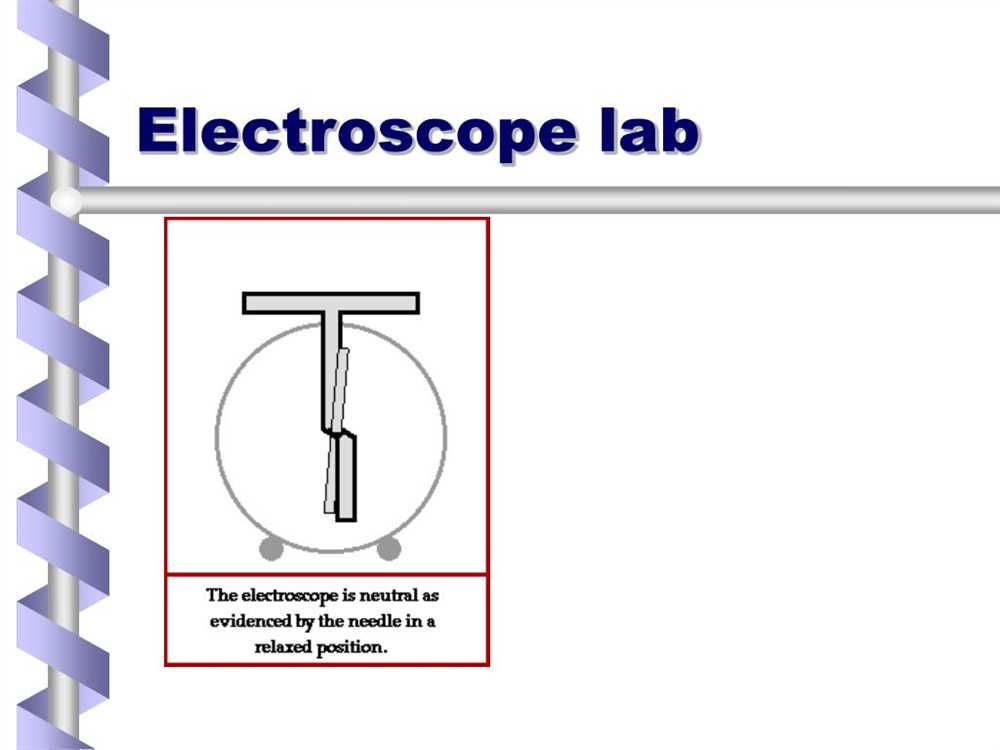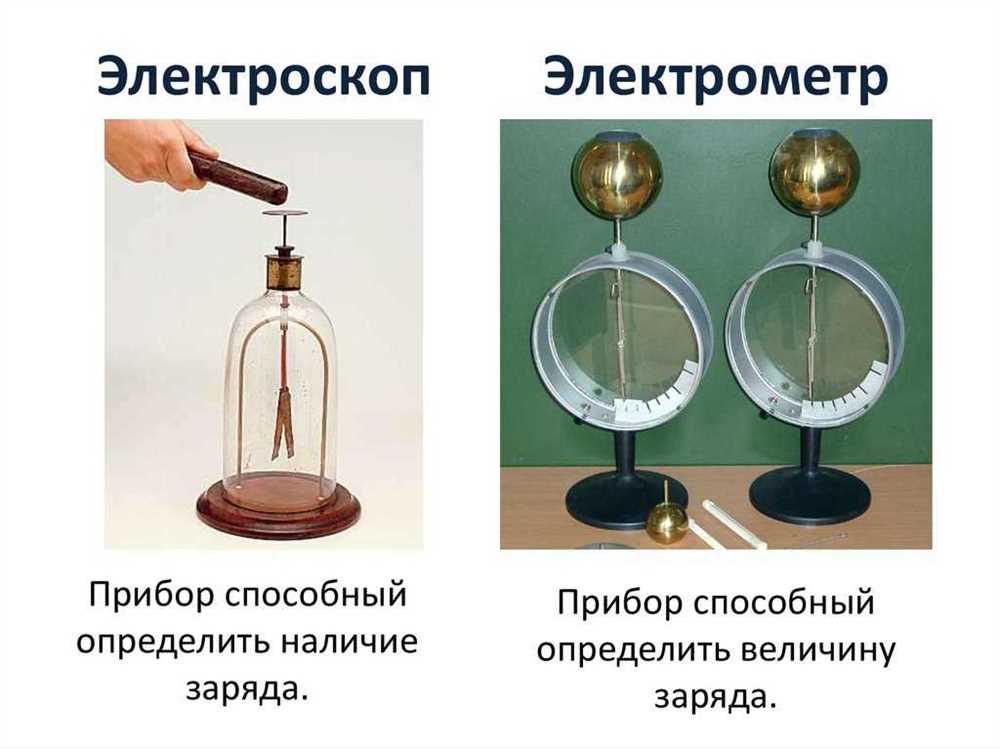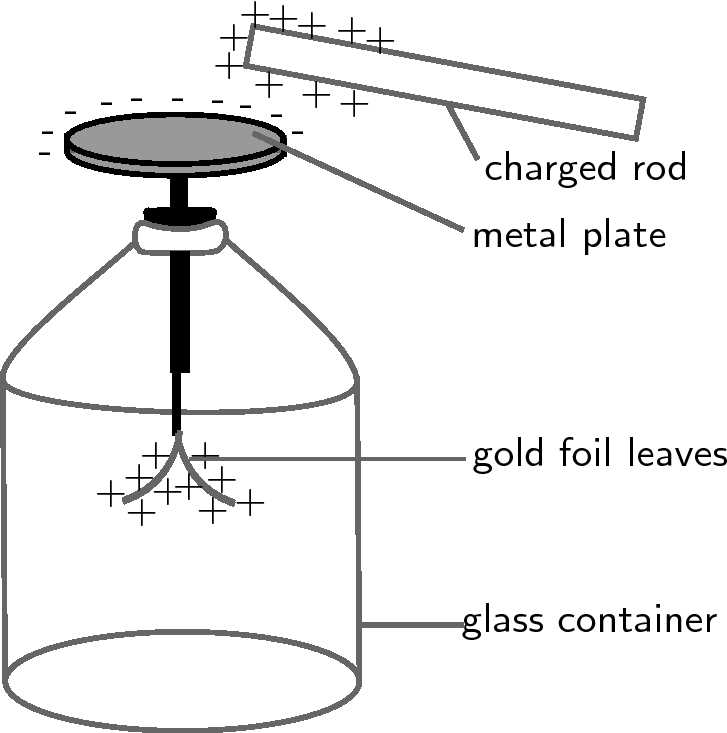
In the field of physics, an electroscope is a device used to detect and measure electric charges. By utilizing the principle of electrostatic induction, an electroscope can indicate the presence and magnitude of electric charges by the movement of its indicator, usually a metal leaf or needle.
In a typical electroscope lab experiment, students are often required to charge the electroscope using various methods, such as friction or induction, and observe the resulting deflection of the indicator. The main objective of such experiments is to understand the behavior and properties of electric charges.
One common question in an electroscope lab is: “What happens to the electroscope when charged with different materials?” This question aims to investigate the concept of charging by friction. Students are provided with a variety of materials, such as fur, wool, and plastic, and are asked to charge the electroscope using these materials. They then observe the deflection of the indicator and conclude which materials can transfer electric charges effectively.
Another question often asked in an electroscope lab is: “How does the distance between the charged object and the electroscope affect its deflection?” This question explores the concept of electric field strength. Students are instructed to charge an object and move it closer or farther away from the electroscope while observing the indicator’s movement. Through this experiment, they learn that the closer the charged object is to the electroscope, the stronger the electric field and the greater the deflection of the indicator.
What is an electroscope?
An electroscope is a scientific instrument used to detect and measure electric charges. It consists of a metal rod or stem that is connected to a pair of thin metal leaves or foils. The rod is usually housed in a glass or plastic case to protect it from external influences.
When an electric charge is applied to the metal rod of the electroscope, the charges distribute themselves throughout the metal leaves. As like charges repel each other, the leaves will move apart from each other, providing a visible indication of the presence of the electric charge. The greater the charge applied, the farther apart the leaves will move.
The electroscope can also be used to determine the type of charge present. If a positively charged object is brought near the metal rod, it will cause the leaves to move apart even more, indicating a repulsion between the positive charge of the object and the positive charge already present in the electroscope. Conversely, if a negatively charged object is brought near, it will cause the leaves to move closer together, indicating an attraction between the negative charge of the object and the positive charge in the electroscope.
Electroscopes are commonly used in various scientific experiments and demonstrations to study the principles of electricity and static charges. They can be built and calibrated to measure the magnitude of electric charges and can be used to investigate the properties of different materials or to test the effectiveness of different insulators or conductors.
How does an electroscope work?
An electroscope is a scientific instrument used for detecting and measuring electric charge. It operates based on the principles of electrostatics, which involve the behavior of stationary electric charges.
At the core of an electroscope is a metal rod or plate, called the terminal, which is connected to a metal disc or sphere. When an electric charge is applied to the terminal, it induces a redistribution of charges within the electroscope. If the charge is positive, it will repel or push away like charges within the electroscope, causing them to move to the opposite end. If the charge is negative, it will attract opposite charges within the electroscope, causing them to move towards the terminal.
An electroscope can be visualized as a simple mechanical system. When the charge is applied, the movement of charges within the electroscope causes the metal rod or plate to be pushed or pulled, depending on the type of charge. This movement can be observed visually by the deflection of a lightweight metal foil or needle attached to the terminal.
In addition to visual observation, an electroscope can also be used to measure the magnitude of an electric charge. By using known standards of charge, such as a calibrated capacitor or a charged plate, the deflection of the electroscope can be used to determine the amount of charge applied to the terminal. This allows for quantitative analysis of electric charges and helps in various scientific experiments and measurements.
In summary, an electroscope works by detecting and measuring the movement of charges induced by an applied electric charge. It provides a visual indicator of electric charge and can be used for quantitative measurements in electrostatics.
Charging an electroscope
When it comes to charging an electroscope, there are several methods that can be used to induce a charge on the electroscope’s metal plate. One common method is known as charging by induction. To charge an electroscope by induction, begin by bringing a charged object, such as a negatively charged balloon, close to the electroscope. The negatively charged balloon will repel the electrons in the electroscope, causing them to move away from the metal plate and towards the leaves of the electroscope.
As the electrons move towards the leaves, they will temporarily neutralize the positive charge in the leaves, causing them to spread out or diverge. This is known as the charging by induction process. After charging by induction, the negatively charged balloon should be removed and the electroscope will now have a positive charge. This positive charge will cause the leaves to remain separated, indicating that the electroscope is charged.
It’s important to note that charging an electroscope by induction does not transfer charge from one object to another. Instead, it redistributes the charge within the electroscope itself. Charging by induction is useful in experiments when you want to charge an electroscope without directly touching it with a charged object. This method allows for more control and precision in the charging process.
Overall, charging an electroscope by induction is an effective method for inducing a charge on the electroscope’s metal plate. It involves bringing a charged object close to the electroscope, which causes the electrons in the electroscope to redistribute and create a charge imbalance. This process allows for the accurate and controlled charging of an electroscope, making it a valuable technique in various scientific experiments and demonstrations.
Detecting charge using an electroscope
An electroscope is a device used to detect the presence and type of charge on an object. It consists of a metal rod or needle with two leaves attached at the bottom. When a charged object comes close to the electroscope, the charge is transferred to the leaves, causing them to repel away from each other. This repulsion is visually observed and indicates the presence of charge.
The electroscope works based on the principle of electrostatic induction. When a charged object is brought near the electroscope, it induces a separation of charges in the electroscope. The like charges repel each other, causing the leaves to spread apart. If the charged object is positive, the leaves will repel each other even more because the excess positive charge will be attracted to the rod and leave behind a net negative charge on the leaves.
To use the electroscope, we first need to charge it. This can be done by touching the metal rod with a charged object or by rubbing the rod with a material that easily gains or loses electrons. Once the electroscope is charged, we can bring different objects close to it to determine their charge. If the leaves repel each other, we know that the object is charged. By observing the extent to which the leaves spread, we can determine the relative magnitude of the charge.
It is important to note that an electroscope can only detect the presence of charge, not the amount of charge. To measure the amount of charge, additional instruments such as an electrometer or a gold-leaf electroscope may be used. However, the basic electroscope is a simple and effective tool for qualitative charge detection in educational and experimental settings.
Types of electroscopes
Electroscopes are an important tool used in physics experiments to detect and measure the presence of electric charges. There are several types of electroscopes that are commonly used in laboratories:
Leaf electroscopes
One of the most basic types of electroscopes is the leaf electroscope. It consists of a metal rod with two thin metal leaves attached to the bottom. When an electric charge is applied to the metal rod, the leaves repel each other and move apart. This movement can be observed and measured to determine the presence and magnitude of the charge.
Pith ball electroscopes

Another type of electroscope is the pith ball electroscope. It consists of a small lightweight ball, usually made of pith (a spongy plant material), suspended from a string. When an electric charge is applied to the ball, it is attracted to objects with opposite charges and repelled by objects with like charges. This movement of the pith ball can be used to determine the presence and nature of the charge.
Gold-leaf electroscopes

Gold-leaf electroscopes are more sensitive than leaf electroscopes and are often used in more precise measurements. They consist of a metal rod with two thin gold leaves attached to the bottom. When an electric charge is applied to the metal rod, the gold leaves repel each other and move apart. The degree of movement can be observed and measured to determine the presence and magnitude of the charge.
Quadrant electrometers
Quadrant electrometers are more complex electroscopes that can measure very small electric charges. They consist of four metal quadrants arranged in a circular shape. When an electric charge is applied to the electrometer, the quadrants repel or attract each other, causing a small pointer to move on a scale. The position of the pointer can be used to determine the magnitude and polarity of the charge.
These are just a few examples of the types of electroscopes used in laboratories. Each type has its own advantages and limitations, and the choice of which one to use depends on the specific experiment and the level of precision required. Regardless of the type, electroscopes play a crucial role in studying and understanding the behavior of electric charges.
Pith Ball Electroscope

The pith ball electroscope is a simple electrical device that is used to detect the presence of electric charge. It consists of a small, lightweight ball, usually made of pith or a similar material, that is suspended by a thin thread. When an electrically charged object is brought near the pith ball, it will be attracted or repelled by the object, causing the ball to move.
To use a pith ball electroscope, the ball is first neutralized by touching it with a conductor, such as a metal rod, to discharge any existing electric charge. It is then suspended by the thread so that it can move freely. When an electrically charged object is brought near the pith ball, the ball will move towards or away from the object, depending on the type of charge present.
The pith ball electroscope is a useful tool in experiments that involve testing for the presence and type of charge. By observing the movement of the pith ball, scientists can determine whether an object is positively charged, negatively charged, or neutral. The strength of the charge can also be estimated based on the distance and speed at which the pith ball moves.
- The pith ball electroscope can be used to demonstrate the principles of attraction and repulsion in electricity.
- It can be used to test the charging of objects by rubbing them against different materials.
- The pith ball electroscope is also commonly used as a teaching tool in physics classrooms to help students understand the behavior of electric charges.
In summary, the pith ball electroscope is a simple but effective tool for detecting and studying electric charge. Its ability to move in response to nearby charged objects allows scientists and students to observe and analyze electrical phenomena.
Gold-leaf electroscope
A gold-leaf electroscope is a device used to detect and measure the presence of electric charge. It consists of a metal rod with two thin gold leaves attached to the bottom. The top of the rod is connected to a metal disc, which is in turn connected to a metal stem. The stem is insulated from the rod and holds the whole apparatus in place.
When a charged object is brought close to the metal disc, the charges on the object induce a separation of charges in the leaves. Like charges repel each other, so the leaves spread apart. This separation of the leaves provides a visual indication of the presence of electric charge.
The gold leaves are extremely thin and light, making them very sensitive to electrical charges. When a positive charge is applied to the metal disc, electrons in the leaves are repelled and move to the top of the leaves, causing them to spread apart. Likewise, a negative charge applied to the metal disc would attract the electrons in the leaves, causing them to collapse together.
The angle at which the leaves spread apart can be used to estimate the amount of charge present. This can be done using Coulomb’s law, which states that the force between two charged objects is directly proportional to the product of their charges and inversely proportional to the square of the distance between them. By measuring the angle of deflection and knowing the properties of the electroscope, the charge on the object can be calculated.
The gold-leaf electroscope is a simple yet effective tool for detecting and measuring static electricity. It has been widely used in physics experiments and demonstrations to study the behavior of electric charges and explore the principles of electrostatics.
Conducting electroscope experiments
In order to study and understand the behavior of an electroscope, conducting experiments is crucial. These experiments provide valuable insights into how the electroscope works and how various factors affect its functioning.
Charge induction experiment: One of the first experiments that can be conducted with an electroscope is the charge induction experiment. By bringing a charged object near the electroscope, it is possible to observe the deflection of the leaves. This helps in understanding the concept of charge induction and how charges redistribute in an object.
Testing conductivity: Another experiment that can be conducted with an electroscope is testing the conductivity of different materials. By touching the electroscope with materials of varying conductivity, it is possible to observe the degree of deflection. This experiment helps in understanding the conductive properties of different materials and their impact on the electroscope.
Measuring charge: The electroscope can also be used to measure the charge of an object. By charging the electroscope with a known charge and then bringing it near an unknown object, it is possible to compare the deflection of the leaves and determine the charge on the object. This experiment allows for the measurement of charge in a quantitative manner.
Investigating shielding: Shielding is an important concept when it comes to the behavior of an electroscope. By introducing a conducting shield between the electroscope and a charged object, it is possible to observe how the deflection of the leaves is affected. This experiment helps in understanding the role of shielding in charge distribution and the behavior of the electroscope.
By conducting these and other experiments with an electroscope, it is possible to further explore its behavior and understand various concepts related to charge distribution, conductivity, and shielding. These experiments provide practical insights and reinforce the theoretical knowledge of electrostatics.